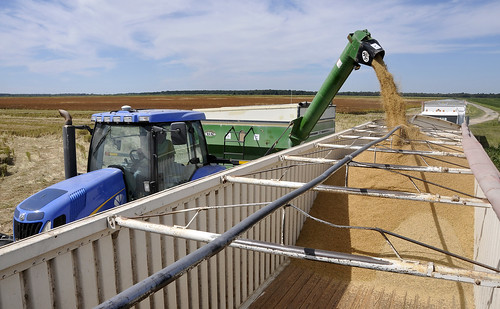Better days ahead in 2020 for Arkansas rice
By Tracy Courage
U of A System Division of Agriculture
Jan. 17, 2020
Fast facts
- Arkansas rice expected to rebound in 2020
- Total rice acreage projected to increase 25 percent to nearly 1.5 million acres
- More long-grain, less medium-grain rice to be planted
(658 words)
(Download this story in MS Word format here.)
LITTLE ROCK — While 2019 was doom and gloom for rice producers, 2020 may be the year of the rebound for the state’s largest agricultural export, with total rice acreage expected to increase 25 percent to nearly 1.5 million acres.
“We’re expecting a sharp increase in total rice acres driven by long-grain rice, with a modest reduction in medium-grain acreage,” Scott Stiles, extension economist for the University of Arkansas System Division of Agriculture, said.
Total rice acreage is projected to increase by 290,400 acres from about 1.2 million acres planted last year to about 1.4 million acres this year. Acreage for long-grain cultivars is expected to increase 32 percent from 950,000 acres last year to about 1.3 million acres this year. Medium-grain acreage is expected to decline 8 percent from 205,000 acres in 2019 to 188,600 acres this year, Stiles said.
Rain — and lots of it — plagued rice producers in 2019. Overall, 511,819 acres of rice were not planted due to flooding, putting Arkansas’ share of 2019 U.S. rice production at 45 percent, down from 48 percent in 2018.
“Instead of a 35-year high, we now have long-grain ending stocks that are at their lowest in 16 years,” Stiles said.
Surprising 2019 yields
Despite a record year for prevent planting, yields remained good.
Planting between March 21 and April 3 typically produces the best yields, Jarrod Hardke, extension rice agronomist for the Division of Agriculture, said, but those dates came and went last year, leaving rice producers with their slowest planting in 25 years.
“Our true summer happened in late August,” he said. “The majority of what affects milling issues depends on what happens after heading. Usually the later the plant, the better the head rice yields. In 2018, we saw the opposite, but this year we had some phenomenal millage yields.”
Currently, rice is grown in 40 of the state's 75 counties, primarily in the eastern half of Arkansas. Counties in northeastern Arkansas account for the majority of production, with Poinsett, Jackson and Lawrence counties leading production.
Gemini 214 CL, Diamond and Jupiter will continue to be the most popular rice cultivars in 2020.
Low production last year helped avert a long-grain rice price collapse — and may have been the silver lining in the cloud. In May, the U.S. Department of Agriculture forecast long-grain ending stocks to reach the highest level since the mid-1980s. At that time rice futures prices were trading near $10 per cwt. By September, futures prices had climbed to $12 per cwt.
Futures contracts are starting 2020 well above $12 per cwt, with March 2020 rice futures currently trading at $13.22 per cwt, Stiles said.
Regarding 2020 inputs, seed costs for rice have remained mostly unchanged over the past year, and fertilizer prices are below early 2019 levels.
“The fact we haven’t seen sharp increases in the largest drivers of input costs works in favor of rice acreage this year,” Stiles said. “Recent political events in Iraq and Iran moved the energy markets significantly higher. How this will impact fuel costs is something we’re watching closely.”
Game changers in the offing
So what — besides weather — could be a potential game changer for rice in 2020?
If the “Phase 1” trade agreement with China includes significant agriculture commodity purchases, particularly in the first quarter of this year ahead of planting, that could move competing crops like corn and soybean prices to more attractive levels, Stiles said.
Also, if dry conditions in parts of Argentina and Brazil persist and production estimates start to decline, corn and soybean prices would get a lift from that as well.
Soybean prices, however, will have to increase a lot to steal rice acres. The $10 price level for soybeans would begin to get grower’s attention. November 2020 soybean futures have rallied over 50 cents in the past month and currently trade near $9.70 per bushel.
To learn about Extension programs in Arkansas, contact your local Cooperative Extension Service agent or visit www.uaex.uada.edu. Follow us on Twitter at @AR_Extension.
About the Division of Agriculture
The University of Arkansas System Division of Agriculture’s mission is to strengthen agriculture, communities, and families by connecting trusted research to the adoption of best practices. Through the Agricultural Experiment Station and the Cooperative Extension Service, the Division of Agriculture conducts research and extension work within the nation’s historic land grant education system.
The Division of Agriculture is one of 20 entities within the University of Arkansas System. It has offices in all 75 counties in Arkansas and faculty on five system campuses.
Pursuant to 7 CFR § 15.3, the University of Arkansas System Division of Agriculture offers all its Extension and Research programs and services (including employment) without regard to race, color, sex, national origin, religion, age, disability, marital or veteran status, genetic information, sexual preference, pregnancy or any other legally protected status, and is an equal opportunity institution.
###
Media Contact: Tracy Courage
Dir. of Communication Services
U of A Division of Agriculture
Cooperative Extension Service
(501) 671-2126
tcourage@uada.edu
